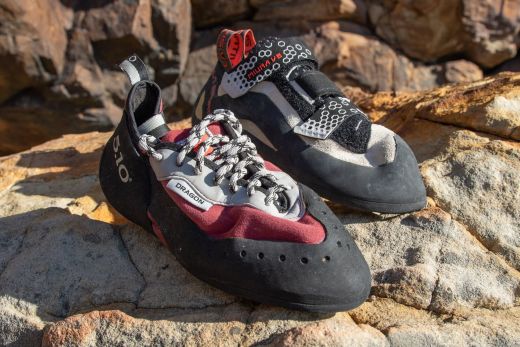Lighter carabiners can reduce the weight of your rack, and skinny ropes can make clipping easier. But when a red point depends on your ability to stand on a smidgen of a foothold, it’s your shoes that make all the difference. It’s no surprise then that rock shoes are a hot topic among climbers. Spend enough time around climbing hangouts, and you’ll gather enough information to fill a hundred reviews. The only problem with this shoe beta is that it is rather subjective and unstructured. Bob might say that downturned shoes are the way forward while Julie claims that it’s a squashed toe box that makes all the difference, and you have no way of sorting fact from friction. But that is why you are now reading this: the most comprehensive guide to climbing shoes anywhere and your best bet at finding something close to objective truth.
- Profile
- Uppers material
- Closure systems
- Stiffness and sensitivity
- Shoes for different styles of climbing
- How to size climbing shoes
Profile
Of all the things to consider when choosing a new pair of shoes, none is more important than a shoe’s profile or shape. Of course, you don’t need to know much about shoe design to find a suitable shoe. You could just try pair after pair until you find shoes that fit. But, it would be a lot faster if you knew what you were looking for and could narrow down your options according to the following four aspects of shoe design.
- Camber
- Toe box
- Heel cup
- Volume
Camber
This is one aspect of a shoe’s profile that should be determined by the type of rock you climb. Generally flat shoes are better at vertical or low-angled terrain while more downturned shoes are better for steeper terrain, but there’s more to camber than its ability to help you engage overhanging rock.
Neutral or flat
Flat or neutral shoes tend to have a little more space at the front of the toe box to allow your toes to lie flat or at least less bent. This more relaxed fit makes them ideal for beginners, whose feet have yet to toughen up, and for experienced climbers who want a more comfortable shoe that they can leave on during long multi-pitch climbs.
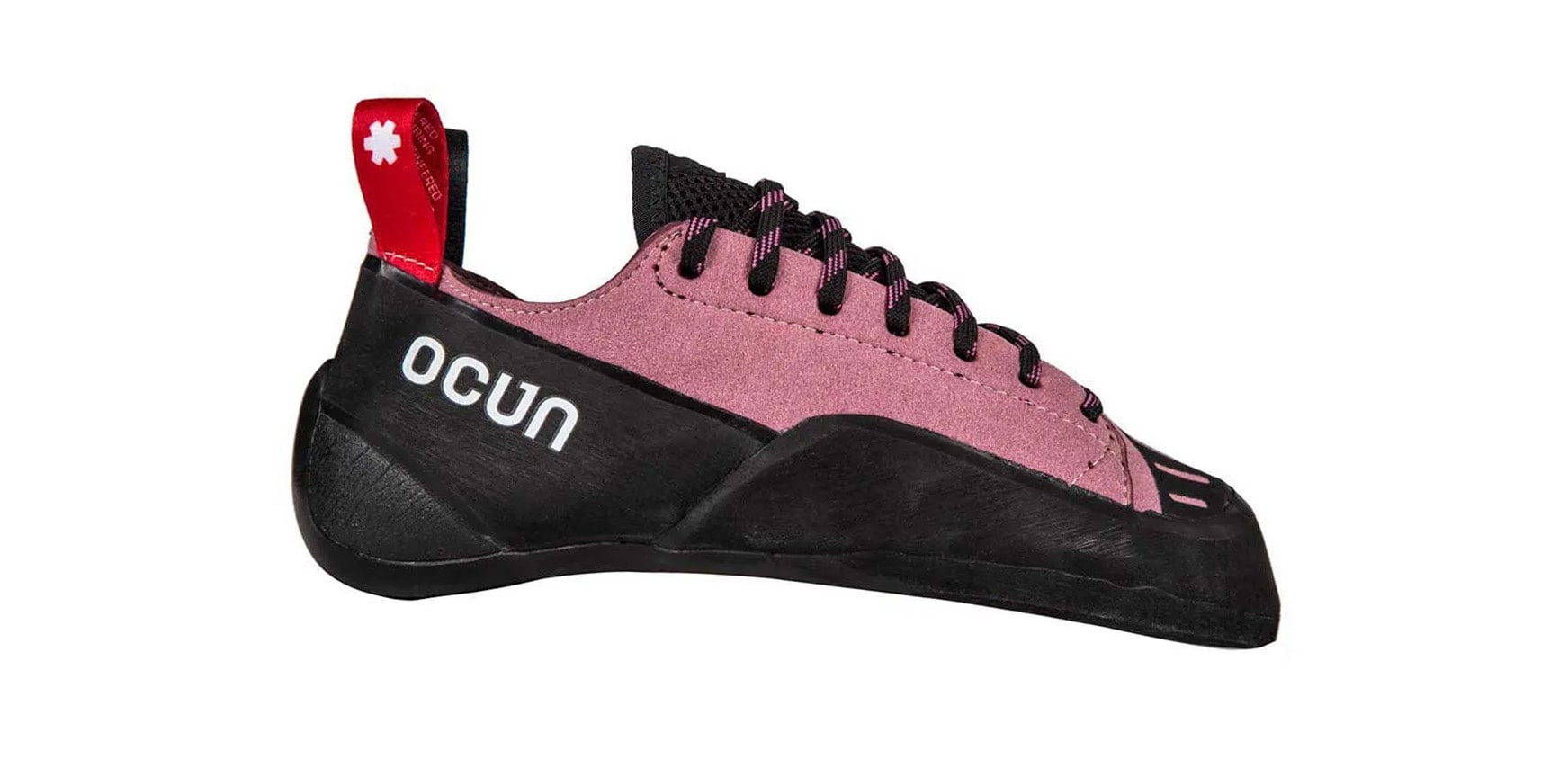
But neutral profile shoes aren’t only for cruising easy stuff. Most popular brands produce at least a few performance-focused flat-soled shoes. Almost all of these will be the right shape for jamming cracks and smearing on low-angled slabs, and those with a stiffer sole will also excel at edging on vertical faces. It’s no surprise then that this type of shoe is popular with tradsters and other climbers who want a shoe that can do it all.
Moderate
For versatility, it’s hard to beat a pair of technical flat-lasted shoes. However, when slabs and cracks aren’t in the forecast, most climbers reach for a pair of slightly downturned shoes. And there’s a good reason for that. While neutral shoes are better suited to cracks and low-angled rock, there’s an equally significant advantage to shoes that have a bit of camber.
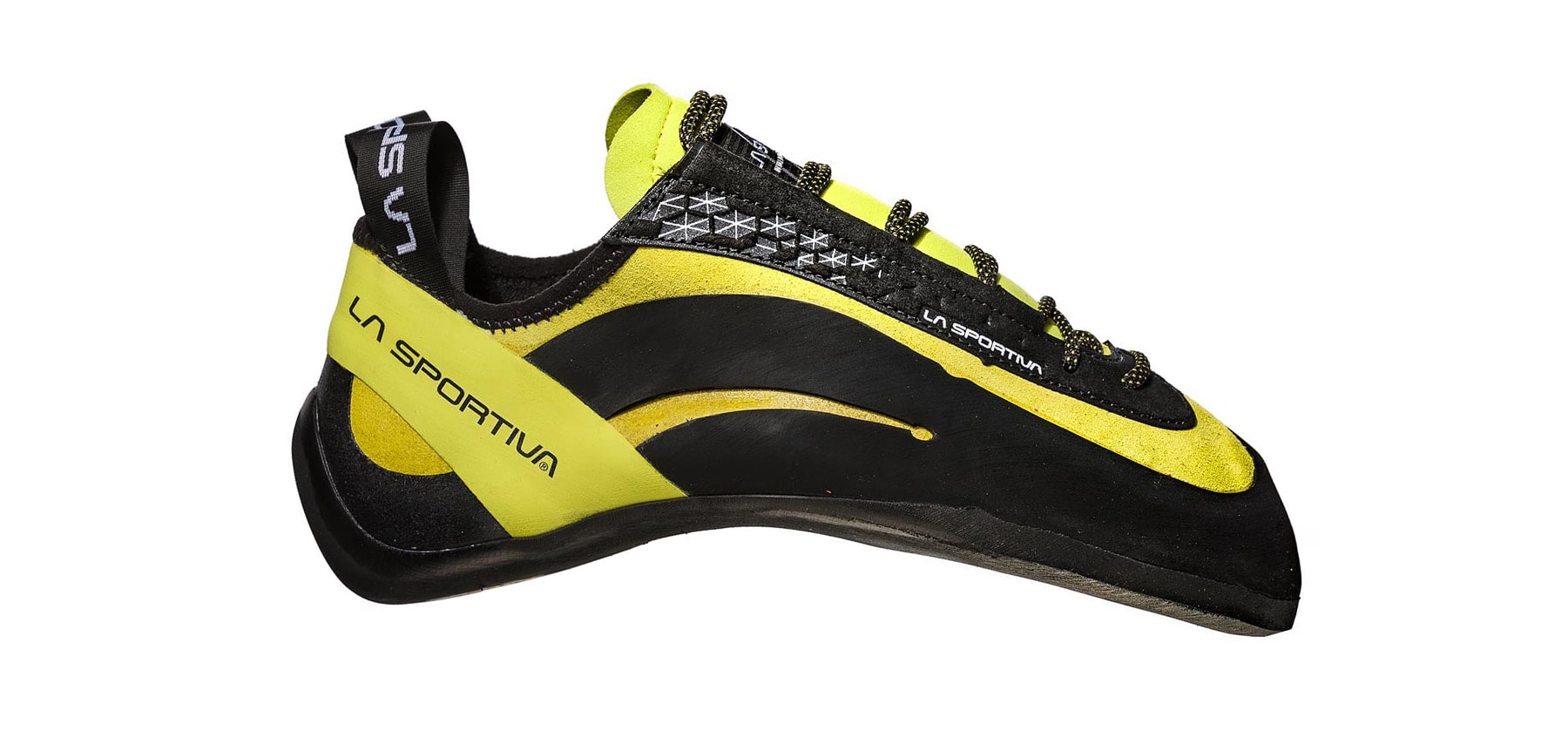
Most climbers recognise that a downturned toe makes it easier to engage steep rock, but that’s not the only way in which camber can help you. A downturned toe also allows you to pull on footholds. Think about how you can pull on a feature once you’ve curled a finger around it. You can do the same with cambered shoes – and that’s useful on both steep and vertical rock.
Aggressive
Shoes with this kind of profile look like the hooked beak of a bird of prey. All that downturn is designed to help you square up a shoe's edges with features in roofs and other ridiculously steep rock. But steep edging is not the only special ability in an aggressive shoe’s box of tricks. As allround steep rock specialists, these shoes are designed to excel at heel hooks and toe hooks too.
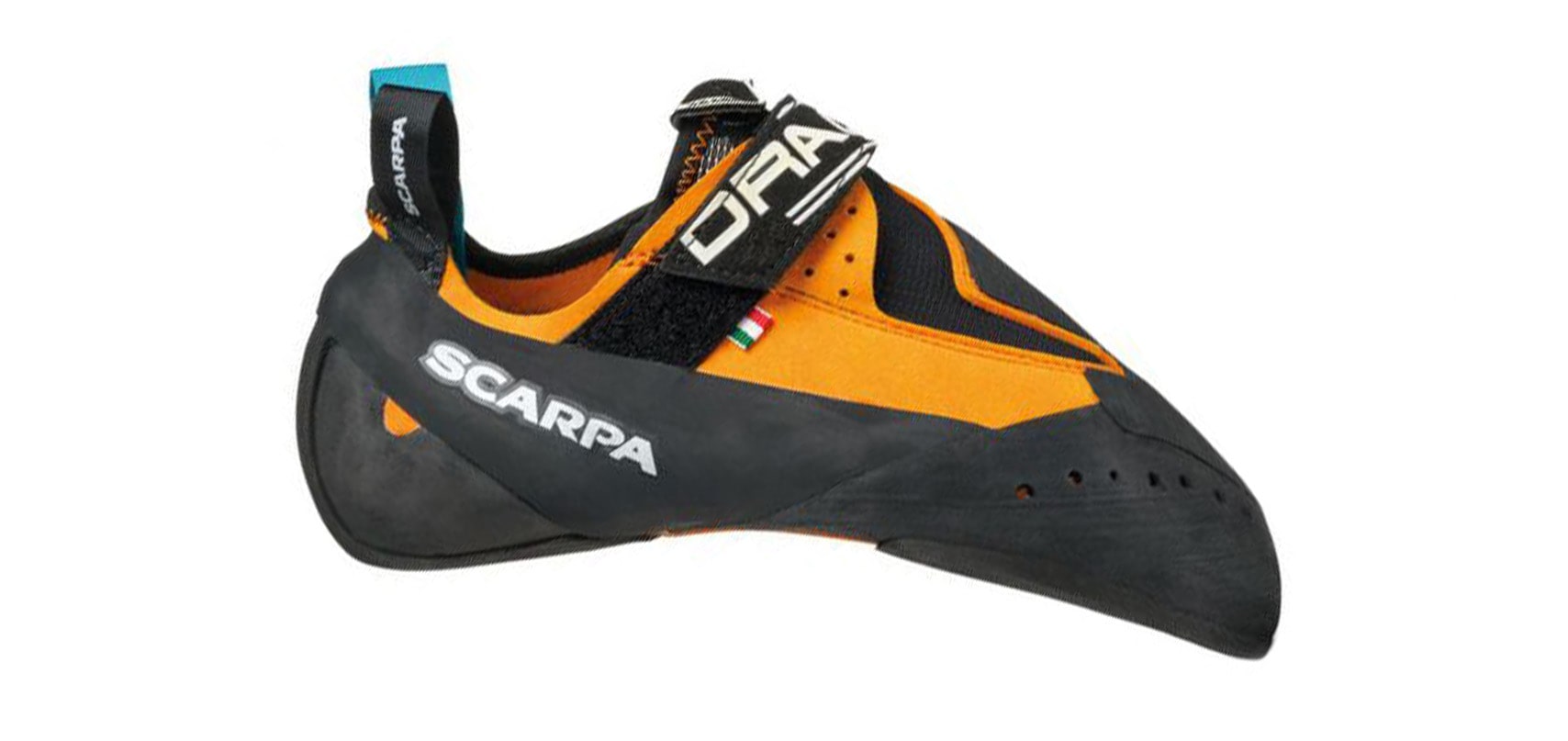
Such performance comes only with squashed toe boxes and lots of heel tension, and that unfortunately makes these shoes a bit uncomfortable. As a result, most climbers typically use these shoes only for single-pitch sport climbs, gym climbs and bouldering, situations in which they only have to wear their shoes for several minutes at a time.
Toe box
Precise footwork begins in your big toe, the main point of power and pivot point for your entire foot. But it doesn’t work alone. The other piggies play a supporting role by creating tension through your feet and transferring power up into your lower legs. For these five digits to work together, they have to be harnessed properly, and that means a snug-fitting toe-box. Of course, what’s snug for one climber might not be snug for another, and that’s because some of us have feet that are more symmetrical while others have feet that are less symmetrical. Shoes manufacturers have even identified three basic foot shapes based on the degree of asymmetry.
Radically asymmetric shoes are more tapered and will suit an Egyptian type foot better, while slightly asymmetric shoes are generally a better fit for a Roman type foot. That’s good news for most people. If you have either of these two foot types, you shouldn’t have much trouble finding a shoe that fits. Things only get tricky if you have a Greek type foot. In this case, the longer second toe (also known as Morton’s toe) is longer than the big toe. In this case the second toe can become painfully bunched in the average toe box, even more so in performance shoes, which are designed with a more asymmetric last to focus power under the big toe. Luckily, some shoe manufacturers, notably Ocun and Mad Rock, produce performance shoes with more rounded toe boxes.
Heel
As shoes get more technical, the heel cup can become a point of differentiation with some models offering better heel hooking performance or more through-shoe tension. But heel cup design also determines whether or not a shoe fits your feet properly. Sometimes it seems like a pair of shoes would fit perfectly if only the heel were a little deeper or shallower. These almost-but-not-quite-right shoes can wrap your toes as if tailor-made but then, when you weight your heel, make a little farting sound. That’s the sound of air escaping from the dead space under your heel. Although not ideal, this might not be a problem if you don’t expect to do any heel hooking in a shoe.
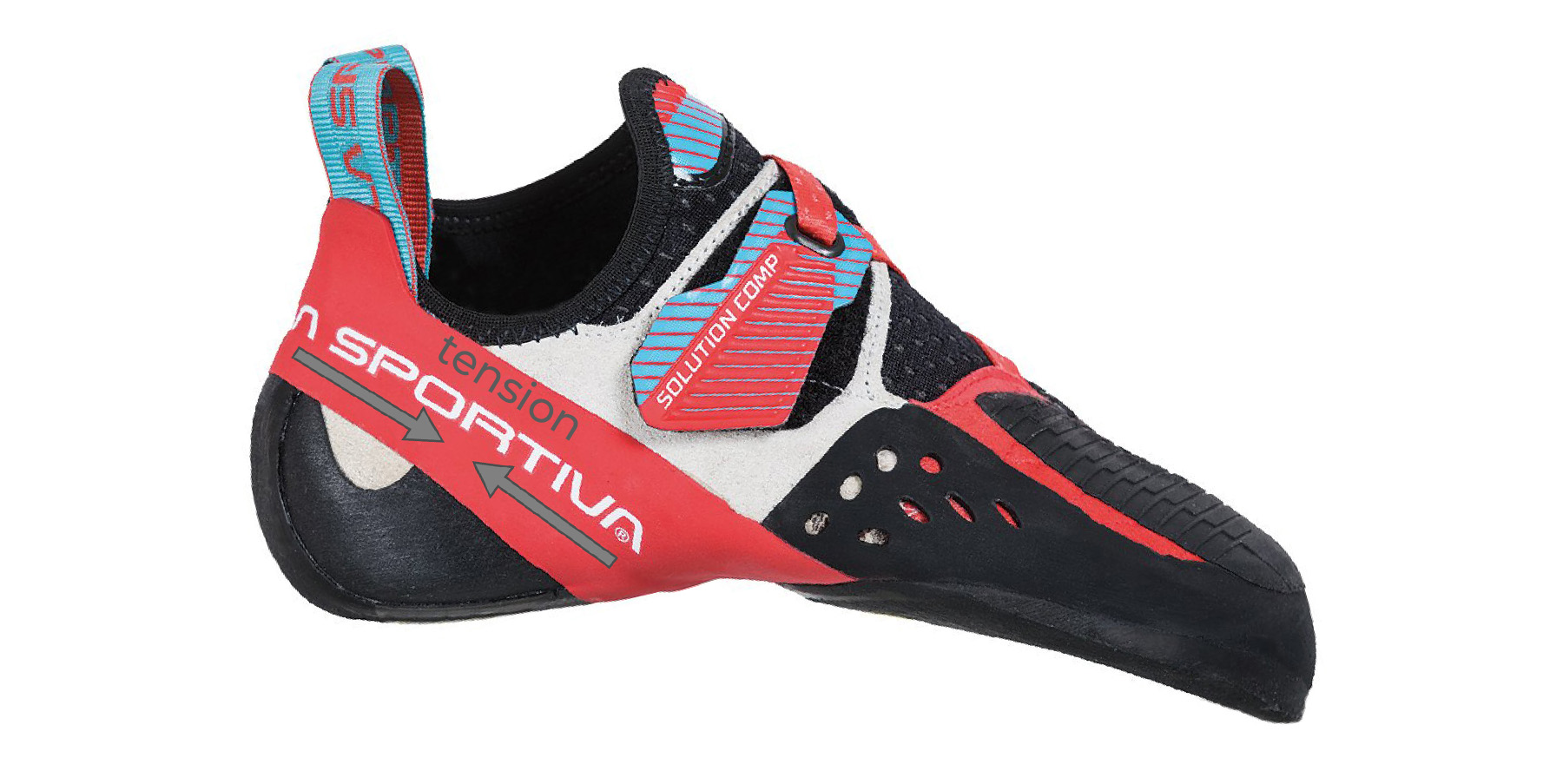
What’s definitely an issue is a heel that nips at your Achilles tendon. This is a hotspot for blisters, and an overly tight heel can cause much discomfort. If getting the right heel fit is proving tricky, consider the degree of arch in your foot. If your foot is flat, the chances are that a shallower heel cup will fit better. And if you have a more pronounced arch, a deep heel cup might be just the ticket.
Volume
Along with toe box shape, volume is one of the most important aspects to consider when choosing a new pair of shoes. And again, most brands follow a recipe when it comes to volume: some manufacturers tend to produce narrower shoes while others tend to produce wider shoes. Five Ten, Boreal, and Evolv and generally known for a wider fit while La Sportiva and Scarpa are generally narrower. But don’t disregard a brand only because it is known to produce shoes that are wider or narrower. There are always exceptions to the rule. The La Sportiva Muira, for example, will suit moderately wide feet (as do some Scarpas). And then there are women’s shoes, which generally have less volume and are a good option for men with narrow feet.
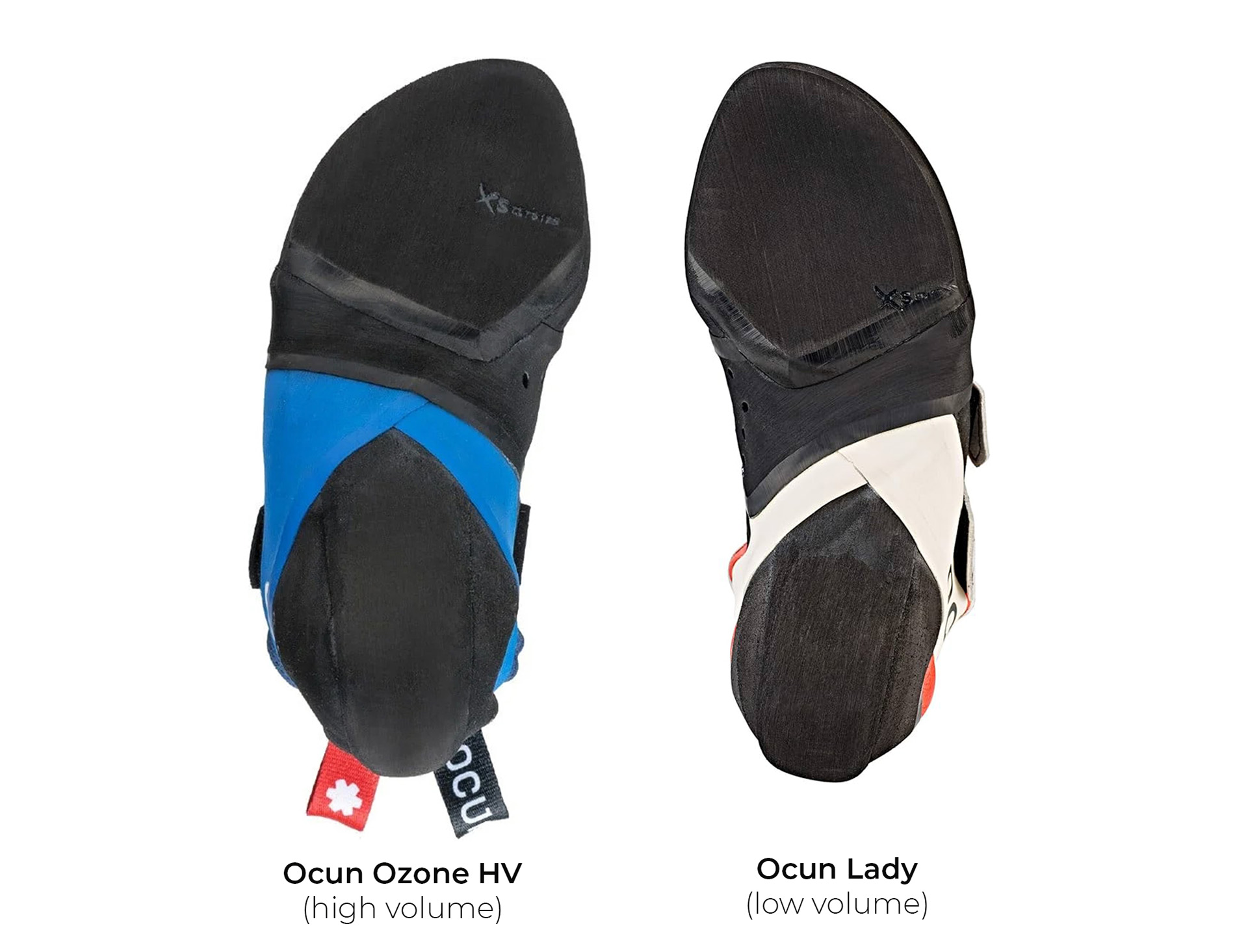
Uppers material
Uppers can be made of one of two types of material: synthetic or leather. The latter can be lined or lined, which broadens your options to three. Your choice should be determined by three factors:
- Stretchiness
- Next-to-skin comfort
- Breathability
Note that while greater comfort and breathability is always a good thing, the ideal amount of stretchiness is a matter of preference. A shoe that stretches more will conform better to the shape of your foot (and be more comfortable), while a less stretchy shoe will retain its shape longer (better for performance).
Unlined leather
Leather shoes – lined and unlined – stretch more than synthetic shoes, and unlined leather shoes stretch more than the lined variety. In just a few solid sessions, unlined leather shoes can stretch up to a full size. Keep this in mind when you size your shoes – they should be tight. Leather shoes also breathe more and are better at preventing sweatiness and pong. Again, unlined shoes are better than lined shoes in this department. This makes them a good option for long sweaty sessions in a hot climbing gym.
Lined leather
Lined leather shoes also stretch, but their lining prevents them from stretching as much as unlined shoes. Whereas unlined shoes can stretch a full size, lined shoes will stretch by only half a size, maybe a little more. If you find yourself trying to decide between a pair of 8’s and 8 ½’s, go with the smaller pair. Lined shoes are also not as breathable as the unlined variety (still better than synthetic), and they will get a bit smelly with time.
Synthetic
Synthetic shoes stretch very little, meaning that they need to fit properly - be the correct size – right out of the box. An uncomfortable pair of new synthetic shoes is probably not going to feel that much better several sessions later. Synthetic shoes are also the least breathable and require the most care if you want to avoid offending your climbing partners with bad foot odour. For this reason synthetic shoes are best reserved for the types of climbing where you’ll be able to take them off regularly.
Closure systems
By now you’ve figured out that velcro shoes are easier to get on and off than lace-ups, but there’s more to closure systems than speed and convenience.
Laces
Lace-ups are still favoured by many climbers for their versatility. They can be laced up tight for technical sections or loosened for less technical terrain and walk-offs. This makes them the preferred choice for longer routes and trad climbs. Laces can also be a good choice for climbers who want the snuggest fit possible (Think of laced uppers as a corset for your foot). The downside to laces is that they can be a bit time-consuming when you want to get into or out of them.
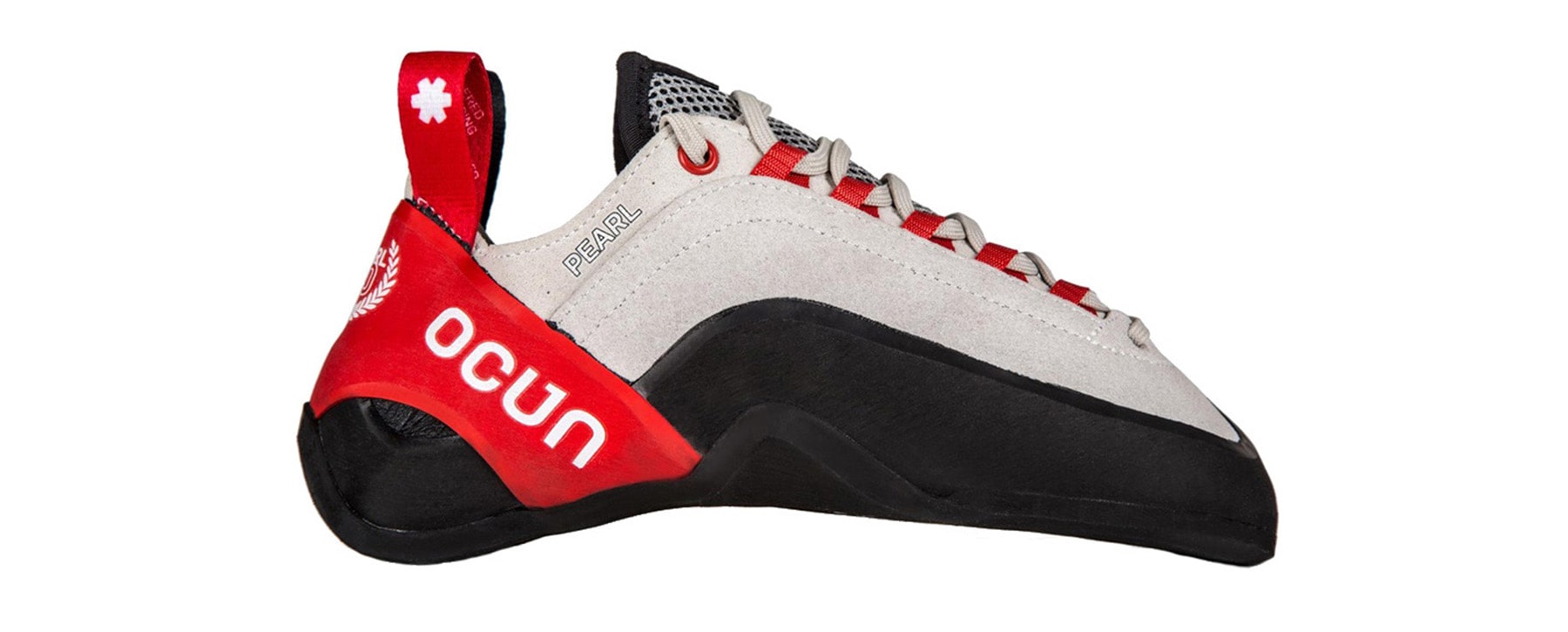
Velcro
This type of closure system represents a middle ground between lace-ups and slip-ons. Like lace-ups, they can be drawn closed – though not quite as tightly – and can still be put on and taken off almost as quickly as a slipper. This makes them great for the kinds of climbing where you’re constantly in and out of your shoes: gym climbing, bouldering and single pitch sport climbing. Some climbers find that velcros also fit the bill for multi-pitch climbs if they can be slipped off between pitches.
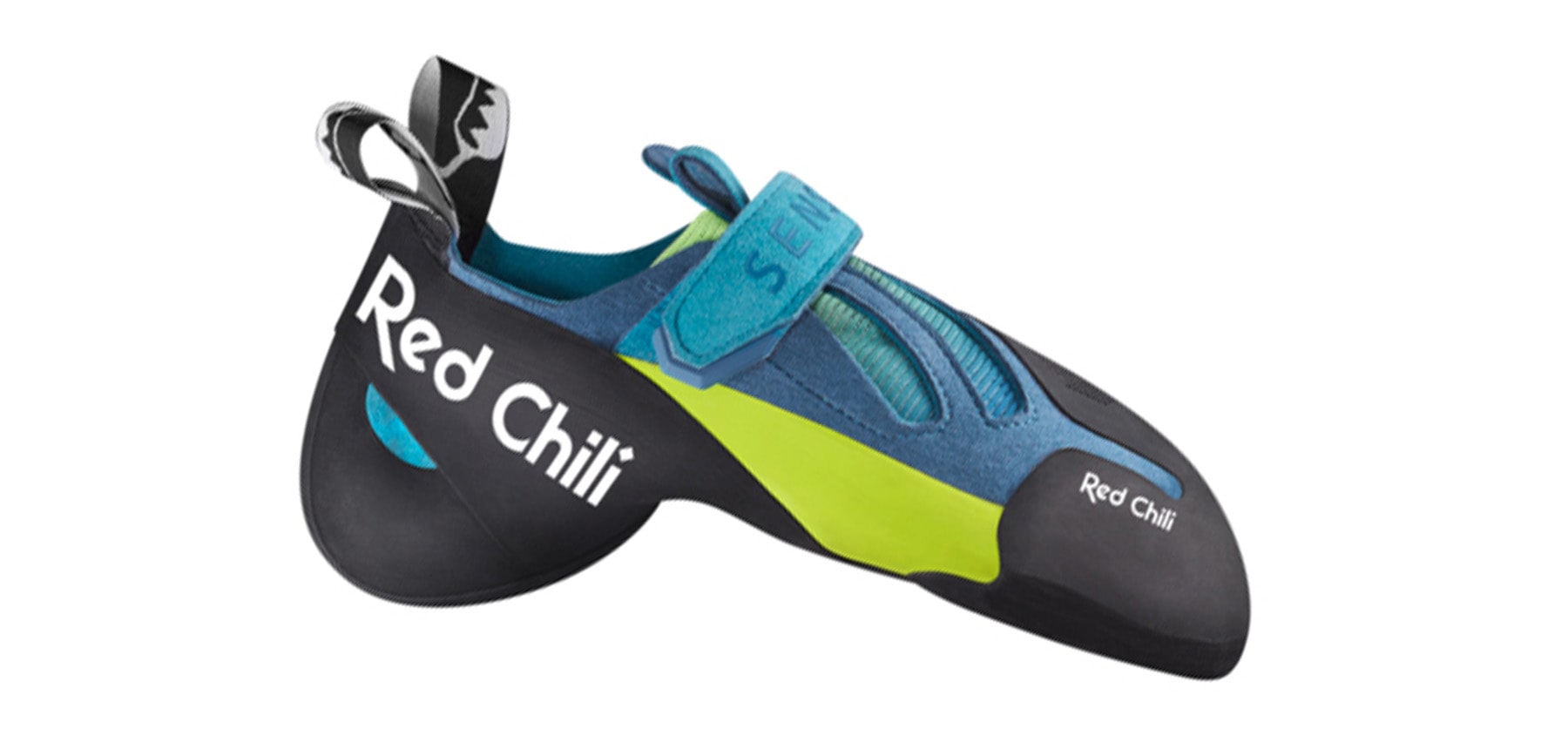
Slip-on
Slippers have an elastic closure system and are generally the softest and most sensitive type of shoe. They’re also the most low profile type of shoe, which makes them great for slotting into thin cracks. Their obvious downside is that they have nothing as secure as laces or straps to bind them. This makes for less than optimal edging performance, but that’s okay for gym climbing and cracks.
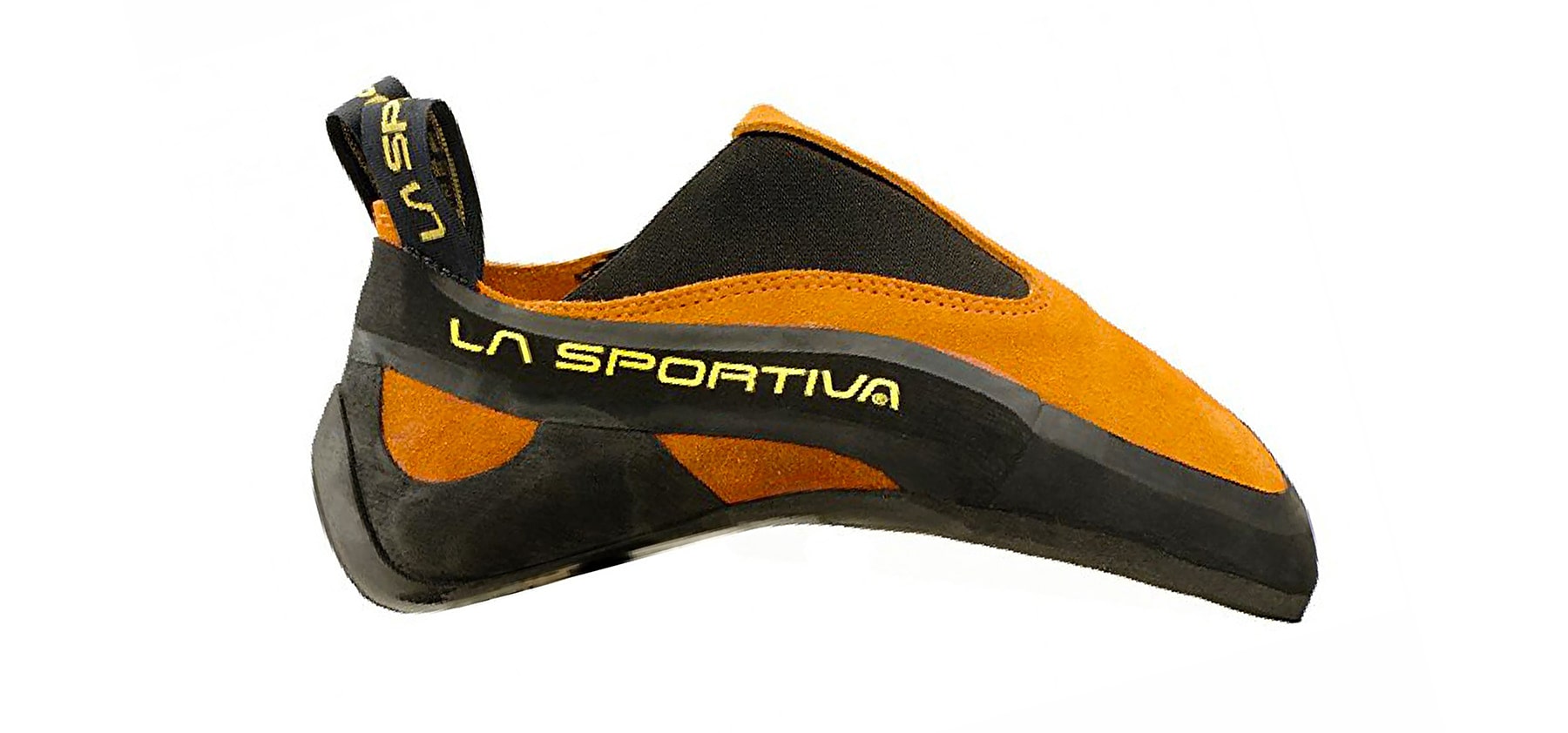
Stiffness and sensitivity
Stiffness is good because it translates to greater edging power, and sensitivity is good because it allows you to feel what’s going on beneath your toes. But you can’t have a hundred percent of both. Stiffness comes at a cost to sensitivity, and there’s always a compromise. You just need to decide what is more important (more about that in the next section). Once you’ve decided which you need more of, consider the following.
Midsole stiffness
There was a time when climbing shoes could be board-lasted (stiffer) or slip-lasted (more flexible). Board-lasted climbing shoes have since gone the way of the Dodo and for good reason: slip-lasted shoes can be designed with a far greater range of flexibility and stiffness. So we can bury that distinction. Instead of looking for the shoe's last type on a spec sheet (It probably won’t be there), rather look at the thickness of the midsole. This will give you a far better idea of how stiff a shoe will be. Shoes with midsoles of 1mm or thinner are going to be on the soft side, those with midsoles that are 1.1mm to 1.4mm in thickness will be moderately stiff, and those that are 1.5mm and thicker will be very stiff.
Outsole sensitivity and grip
There are two things to be aware of when considering the outsole of a shoe. The first is thickness. A thin rubber sole will be more sensitive, while a thicker sole will be less sensitive but more durable (and stiff). Competition-focussed shoes usually come with thinner soles (as thin as 2.5mm) while beginner shoes and those designed for mileage have soles as thick as 5mm. In most shoes, soles of 3.5mm to 4mm will give you the right balance of sensitivity, stiffness and durability.
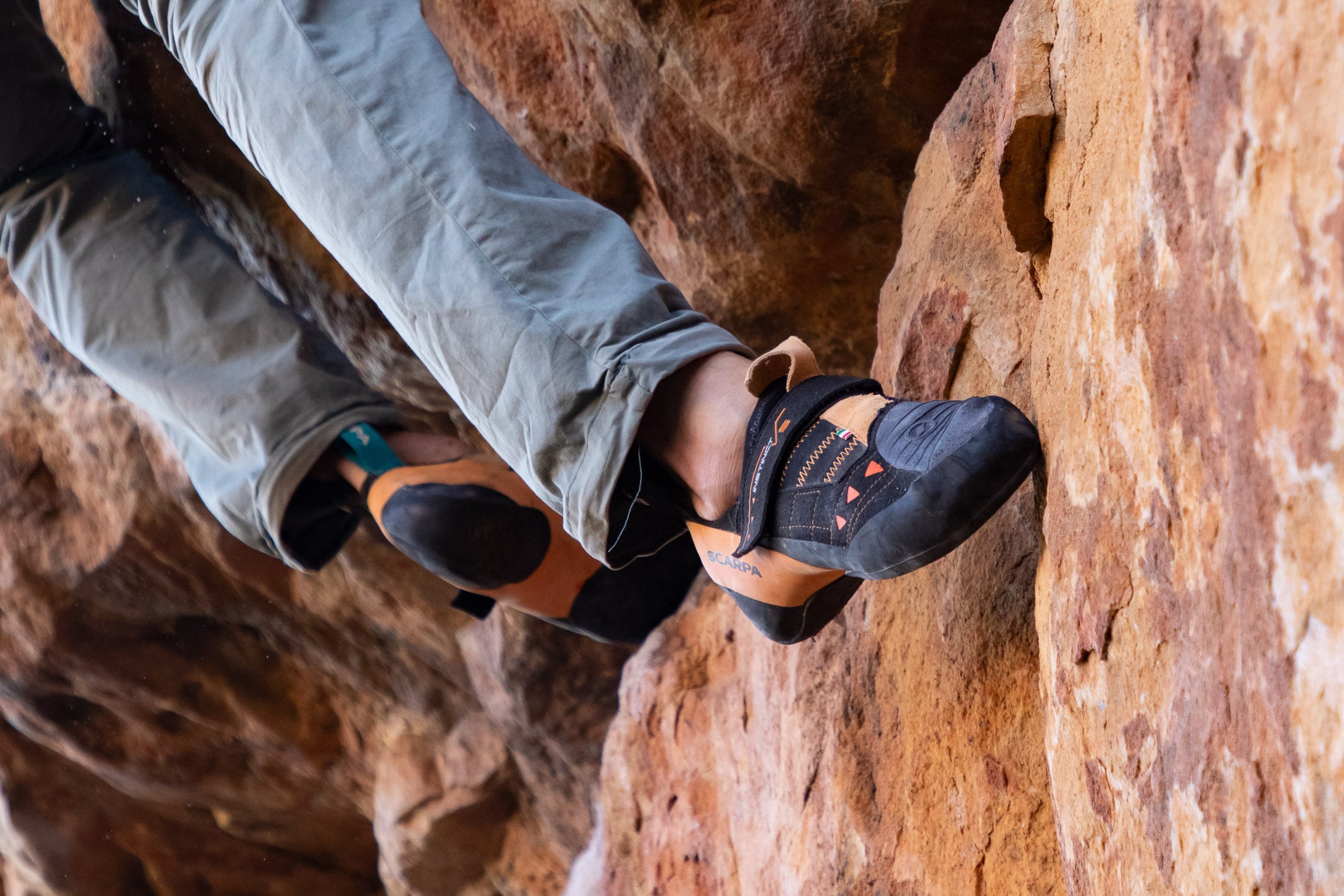
The second thing worth looking at is the rubber compound used. All climbing shoe rubber is sticky, but some compounds are softer and even stickier while others are a little harder and more durable. Vibram’s XS edge, for example, is on the stiffer side and offers maximum edging power and durability. XS Grip 2, on the other hand, is softer and offers the most grip on steeper terrain where it’s hard to bear down hard on footholds. The choice of rubber that a manufacturer uses on a shoe says a lot about what that shoe is intended for.
Shoes for different styles of climbing
If you’ve only recently gotten into this whole climbing thing, the chances are that you’re doing all your climbing in a single pair of shoes. And that’s okay. If you’ve just started out, your footwork probably isn’t good enough for you to notice the difference between performance shoes and your rubber clogs. As you progress, however, you will start to see the benefit in a more downturned toe or a stiffer sole. It’s usually at this point that most climbers start building a quiver or shoes suited to particular styles of climbing.
Beginners
A good beginners shoe is cheap and comfortable. That means a neutral profile with rubber soles thick enough to offer some support and withstand slopper footwork. If you are apprenticing under a trad climber, you might want some comfy leather lace-ups that you can wear for hours. Otherwise a pair of slightly tighter velcros might be a better idea – a little less comfy but easier to get on and off. Some beginners size their shoes to fit over socks. I advise against this. It obviously offers no performance advantage, and while it will make wearing the shoes more comfortable, this also means it will take longer for your feet to toughen up, which they will have to eventually.
Gym climbing
The best shoe for climbing in the gym will depend a lot on the type of climbing you do indoors. If you spend most of your time on vertical lead walls, a slightly downturned shoe makes the most sense, and if you’re going to throw yourself at steeper routes or boulder, an aggressively downturned shoe will probably be best. Some climbers use cheap or resoled shoes for the gym, and those can work fine if your goal is to climb laps and build up endurance. Just know that they won’t help you refine your footwork. If your aim is to use your gym sessions to work on your technique, your gym shoes need to be just as technical as those you climb outside with (if not the same pair of shoes).
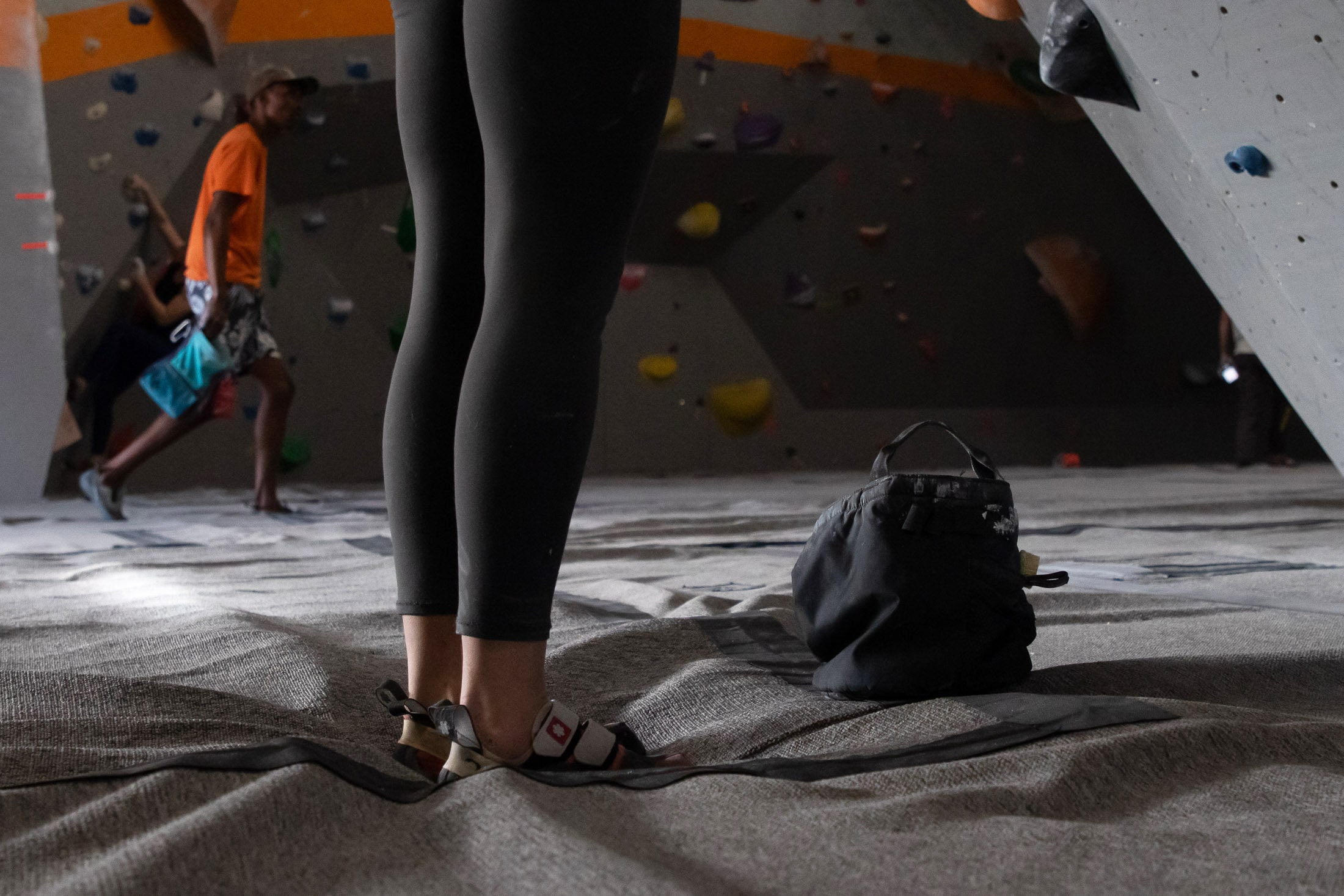
Bouldering
Bouldering shoes are almost always very downturned as they are designed to excel at heel-hooking, toe-hooking and edging on steep terrain. And they’re designed to be tight. You are, after all, not going to wear them for more than a few minutes at a time. It’s no surprise then that bouldering shoes are always designed with a velcro or hybrid slipper closure system. Other features that you are likely to find on a bouldering shoe include patches of softer rubber over the top of the toe box for better toe-hooking, and stiff heels for powerful heel-hooking. Some climbers will use the same shoes for steep and hard sport routes, especially when some fancy footwork is called for.
Sport climbing
A sport climber’s shoes can be as varied as the rock he climbs on. For steep hard routes, you might opt for an aggressively downturned shoe like that you would use for bouldering although you also might want to consider a pair of lace-ups since you won’t take off and put on these shoes as often as you would when bouldering. For rock that is closer to vertical, a slightly downturned or even flat shoe would be a better option depending on your ability and preference – downturned shoes help more advanced climbers really pull on holds with their feet. And for multipitch sport climbing, the right choice of shoe will depend on the type of terrain and whether or not you intend to take your shoes off between pitches.
Trad climbing
Given that the average trad pitch takes significantly longer than the average sport climb, trad shoes generally have to have a more relaxed fit. Many trad climbers prefer flat shoes for this reason with most opting for lace-ups that can be worn more loosely for cruisy sections and then cinched up tight for more technical terrain. Flat shoes are also better for climbing cracks and smearing low-angled slabs, something that trad climbers do a lot of. Some tradsters might even prefer some high-top crack specialists like the La Sportiva TC Pros for maximum performance when jamming cracks. Again, laces are better as they make for a more low-profile shoe that’s easier to get into cracks.
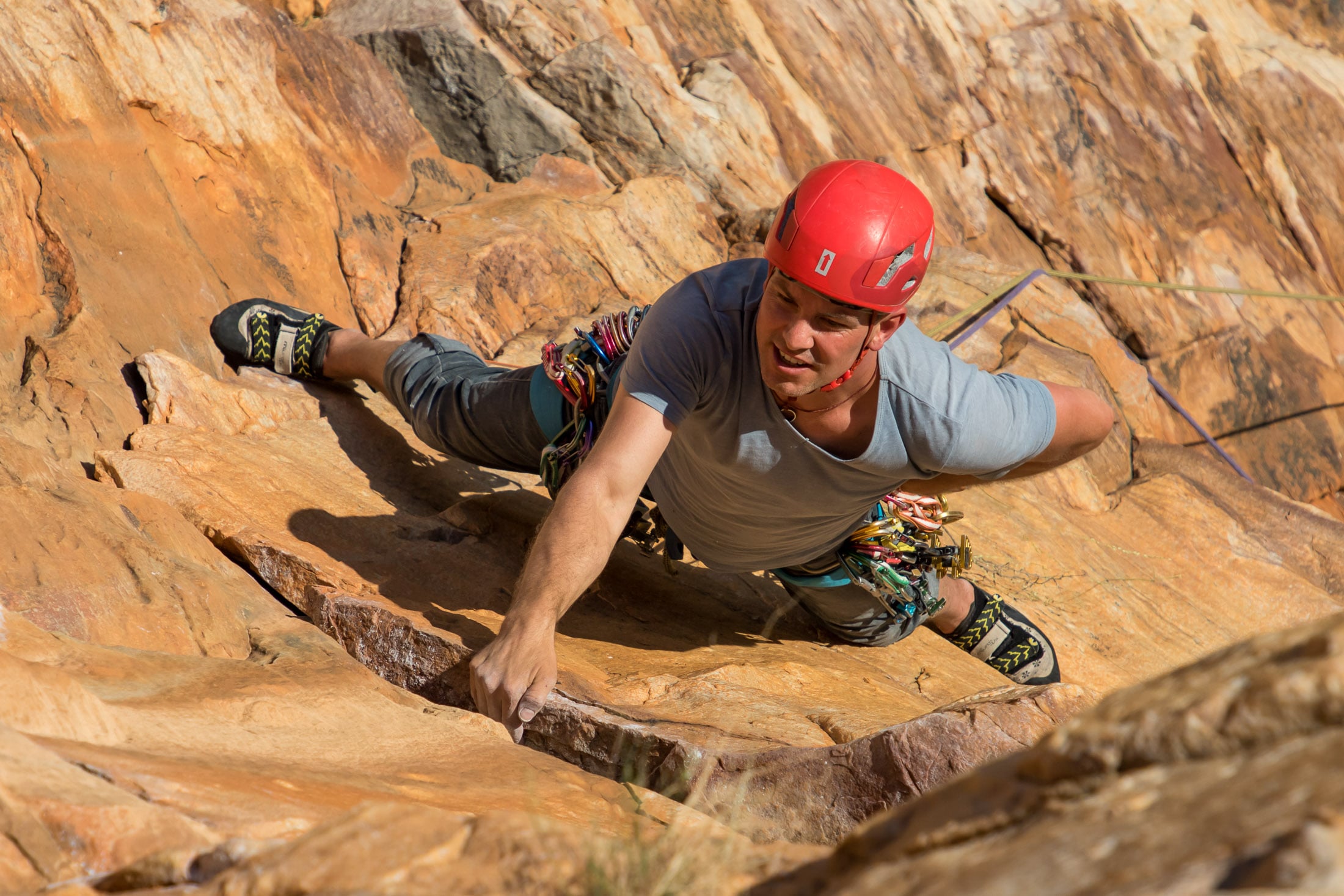
How to size climbing shoes
First, understand that pain does not equal performance. Performance is the result of a design that effectively directs power into your big toe, and that means having the right shape for your foot and a snug fit. That’s snug, not overly tight. A shoe that makes toeing down painful will only dissuade you from bearing down on footholds, and there’s no performance benefit to be had in that. For now, let’s assume that you’ve found a shoe that matches your foot shape and needs, and the next step is to decide on the exact size. There might be two or three sizes that fit, and you aren’t sure which to go with. Here there are two factors to consider:
Uppers material
First, there is the material that the uppers are made of. Unlined leather, lined leather, and synthetic all stretch to different extents. Unlined leather will stretch up to a full size, so you’ll want to get these a size smaller than you want them to be after they’ve stretched. Lined leather shoes will also stretch but only a half size, so go a half size smaller than you want them to be. And synthetic shoes will stretch very little if at all, so size these as you want them.
Climbing style
The second factor is the type of climbing that you are going to be doing. Bouldering and gym climbing (even lead climbing) requires you to spend less time in your shoes, so you can size them a little tighter. Sport routes require you to spend up to 15 minutes (or even longer) on a route, so you’ll need to ensure that you can wear your shoes for at least that long. And trad pitches can take as long as 45 minutes, which means that they have to be even more comfortable.
| When to go up a size | When to go down a size |
| There is dead space in the toe box | The shoe is painfully tight |
| Your toes aren’t even slightly curled | There are obvious pressure points |
| You can pull the heel off easily |
Get more advice from this gearhead
You now have everything you need to know about climbing shoes. But don’t stop here. On this website you’ll find many more in-depth gear guides on everything from ropes to harnesses as well as many more how-to articles. You can find these under the different sections in the categories menu, or, better yet, sign up for my newsletter to get all the latest from Trail & Crag delivered straight to your inbox.
